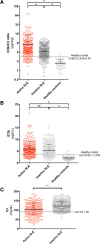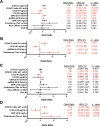Association of Blood Concentrations of Complement Split Product iC3b and Serum C3 With Systemic Lupus Erythematosus Disease Activity
- PMID: 30294950
- PMCID: PMC6393208
- DOI: 10.1002/art.40747
Association of Blood Concentrations of Complement Split Product iC3b and Serum C3 With Systemic Lupus Erythematosus Disease Activity
Abstract
Objective: To examine correlations between blood levels of complement split product iC3b and serum component C3 with clinically meaningful changes in disease activity in patients with systemic lupus erythematosus (SLE).
Methods: A total of 159 consecutive patients with SLE, diagnosed according to the American College of Rheumatology or Systemic Lupus International Collaborating Clinics classification criteria, were enrolled in CASTLE (Complement Activation Signatures in Systemic Lupus Erythematosus), a prospective observational study. Patients with 1-7 study visits were included in this longitudinal analysis. In addition, 48 healthy volunteers were enrolled to establish a normal reference value for the ratio of blood iC3b to serum C3 concentrations. Serum C3 and C4 levels were measured by nephelometry, and blood iC3b levels were measured by a lateral flow assay. SLE disease activity was monitored with the Responder Index 50 instrument of the SLE Disease Activity Index 2000.
Results: Relative changes in the iC3b:C3 ratio, levels of anti-double-stranded DNA (anti-dsDNA) antibodies, and use of a supraphysiologic dose of prednisone (>7.5 mg/day) each independently correlated with SLE disease activity, as determined in multilevel multiple logistic regression analyses. Only the iC3b:C3 ratio was significantly associated with clinically meaningful improvements in disease activity among patients with SLE who were receiving a supraphysiologic dose of prednisone. The iC3b:C3 ratio outperformed C3 and C4 levels with regard to discriminating active SLE from inactive SLE, and major flares from no disease activity. The iC3:C3 ratio, anti-dsDNA antibody levels, erythrocyte sedimentation rate, and use of a supraphysiologic prednisone dose were each independently associated with the presence of lupus nephritis, whereas none of these measures was associated with SLE rash. The association of the iC3b:C3 ratio with lupus nephritis was independent of other observed clinical manifestations.
Conclusion: The ratio of blood iC3b to serum C3 concentrations correlates with the extent of SLE disease activity and with clinically meaningful changes in disease activity in patients with SLE. Furthermore, the iC3b:C3 ratio may discriminate between active and inactive SLE, and between major flares and no active disease.
© 2018 The Authors. Arthritis & Rheumatology published by Wiley Periodicals, Inc. on behalf of American College of Rheumatology.
Figures





Comment in
-
Better Biomarkers for Lupus Disease Activity: Tools for Treating to Target.Arthritis Rheumatol. 2019 Mar;71(3):329-330. doi: 10.1002/art.40797. Epub 2019 Jan 28. Arthritis Rheumatol. 2019. PMID: 30537205 No abstract available.
-
Reply.Arthritis Rheumatol. 2019 Sep;71(9):1590-1592. doi: 10.1002/art.40923. Epub 2019 Jul 19. Arthritis Rheumatol. 2019. PMID: 31074940 Free PMC article. No abstract available.
-
Association of Autoantibody Quantification With Systemic Lupus Erythematosus Disease Activity: Comment on the Article by Kim et al.Arthritis Rheumatol. 2019 Sep;71(9):1588-1590. doi: 10.1002/art.40924. Epub 2019 Jul 19. Arthritis Rheumatol. 2019. PMID: 31074949 No abstract available.
References
-
- Leffler J, Bengtsson AA, Blom AM. The complement system in systemic lupus erythematosus: an update. Ann Rheum Dis 2014;73:1601–6. - PubMed
-
- Atkinson JP. Complement activation and complement receptors in systemic lupus erythematosus. Springer Semin Immunopathol 1986;9:179–94. - PubMed
-
- Lloyd W, Schur PH. Immune complexes, complement, and anti‐DNA in exacerbations of systemic lupus erythematosus (SLE). Medicine (Baltimore) 1981;60:208–17. - PubMed
-
- Dunkelberger JR, Song WC. Complement and its role in innate and adaptive immune responses. Cell Res 2010;20:34–50. - PubMed
Publication types
MeSH terms
Substances
Grants and funding
LinkOut - more resources
Full Text Sources
Other Literature Sources
Medical
Miscellaneous

